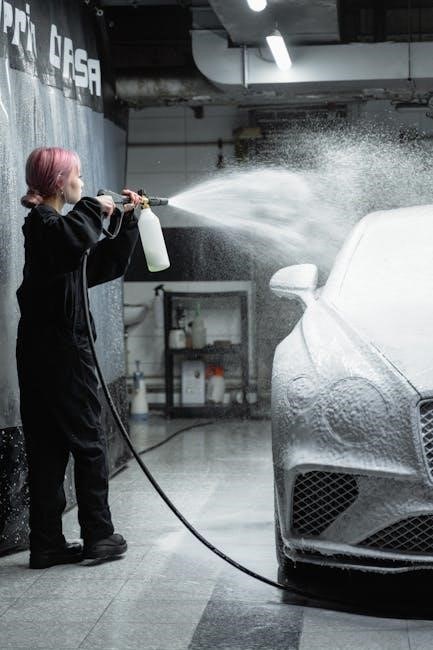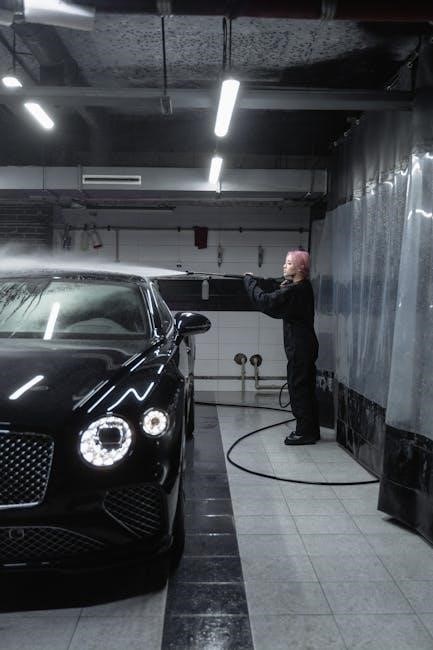The DeWalt 3400 PSI Pressure Washer is a powerful cleaning tool designed for heavy-duty tasks. It features a robust engine and high-pressure output, ideal for industrial and residential use. This manual provides essential guidance for safe operation, maintenance, and troubleshooting to ensure optimal performance and longevity of the unit.
1.1 Overview of the DeWalt 3400 PSI Pressure Washer

The DeWalt 3400 PSI Pressure Washer is a high-performance, gas-powered cleaning solution designed for demanding tasks. With 3400 PSI and 2.5 GPM, it delivers strong cleaning power, suitable for driveways, heavy equipment, and industrial surfaces. Its durable design ensures long-term reliability. The unit is portable, making it easy to transport to various job sites. This manual guides users through assembly, operation, and maintenance to maximize efficiency and safety. It emphasizes reading the manual thoroughly before use, especially for safety precautions, to avoid hazards like operating in explosive environments. Proper usage and care will extend the product’s lifespan and ensure effective and optimal cleaning results.
1.2 Importance of Reading the Owner’s Manual
Reading the owner’s manual is crucial for safe and effective operation of the DeWalt 3400 PSI Pressure Washer. It provides detailed instructions on assembly, usage, and maintenance to ensure optimal performance. The manual highlights safety precautions, such as avoiding explosive environments and proper ventilation, to prevent accidents. Understanding the safety symbols and guidelines is essential to operate the unit responsibly. Failure to follow the manual’s instructions may result in hazards or damage to the equipment. Additionally, the manual outlines warranty terms and conditions, ensuring compliance for coverage. Taking the time to thoroughly read and understand the manual guarantees a safer and more efficient cleaning experience with the DeWalt 3400 PSI Pressure Washer.
1.3 Safety Precautions and Warnings
Operating the DeWalt 3400 PSI Pressure Washer requires strict adherence to safety guidelines to prevent accidents. Warning labels and safety symbols on the unit highlight critical precautions, such as avoiding explosive environments and ensuring proper ventilation. Never operate the washer near open flames or sparks, as it may ignite flammable fumes. Keep the area well-ventilated to avoid inhaling harmful gases. Always wear protective gear, including gloves and safety goggles, to protect against high-pressure spray and debris. Additionally, the unit is heavy, so lifting should be done with assistance to prevent injury. Ignoring these warnings can lead to serious injury or equipment damage, making it essential to follow all safety protocols carefully.

Safety Instructions and Guidelines
Always follow safety guidelines when operating the DeWalt 3400 PSI Pressure Washer. Ensure proper ventilation, avoid explosive environments, and wear protective gear to prevent accidents and injuries.
2.1 General Safety Warnings
Always read and understand the owner’s manual before operating the DeWalt 3400 PSI Pressure Washer. Ensure the area is well-ventilated and free from flammable materials. Never operate the unit in explosive environments or near open flames. The pressure washer is heavy, so lifting requires assistance to avoid injury. Properly dispose of waste materials to minimize environmental impact. Wear protective gear, including safety glasses and gloves, during operation. Failure to follow safety guidelines may result in serious injury, equipment damage, or environmental harm. Keep the unit out of reach of children and unauthorized users. Adhere to all safety instructions to ensure safe and effective operation.
2.2 Operating in Explosive Environments
Operating the DeWalt 3400 PSI Pressure Washer in explosive environments is strictly prohibited. Such environments may contain flammable gases, vapors, or dust, which could ignite due to engine operation or sparks. Always ensure the unit is operated in well-ventilated areas free from obstructions or hazardous materials. Failure to adhere to this warning could result in fire, explosion, or severe injury. Additionally, avoid operating the pressure washer near open flames, hot surfaces, or sparks. Proper ventilation is critical to prevent the accumulation of fumes or vapors. If unsure about the safety of the environment, do not operate the unit until the area is confirmed safe by a qualified professional.
2.3 Ventilation Requirements
Proper ventilation is essential when operating the DeWalt 3400 PSI Pressure Washer to ensure safety and prevent potential hazards. Always operate the unit in well-ventilated areas, free from obstructions or confined spaces where fumes or vapors could accumulate. Avoid using the pressure washer in enclosed environments, such as basements or garages, without adequate airflow. Inhaling exhaust fumes or chemical vapors from cleaning agents can be harmful to your health. Ensure the area is open and ventilated to prevent the buildup of carbon monoxide or other hazardous gases. If operating in a partially enclosed space, ensure cross-ventilation is maintained to avoid fume concentration. Proper ventilation not only protects your health but also ensures the unit operates efficiently and safely.
2.4 Lifting and Handling the Unit
The DeWalt 3400 PSI Pressure Washer is designed to be durable, but it is also heavy and requires careful handling. Lifting the unit should always be done with assistance, as it may exceed the capacity of a single person. Improper lifting can lead to personal injury or damage to the equipment. Use lifting straps or a dolly to transport the pressure washer, especially on uneven surfaces or stairs. Avoid sudden movements and ensure the area is clear of obstacles. Always maintain a firm grip and lift with your legs rather than your back to prevent strain. If the unit is too heavy, consider using mechanical aids or seeking help from others to ensure safe handling and transportation. Regular inspection after moving the unit is recommended to ensure no damage has occurred. Proper lifting techniques are essential for maintaining both your safety and the longevity of the pressure washer.

Assembly and Initial Setup
Proper assembly and initial setup are crucial for the DeWalt 3400 PSI Pressure Washer to function efficiently. Begin by unpacking and inventorying all parts to ensure nothing is missing. Inspect the hardware for damage or defects and prepare the components according to the manual’s instructions. Follow the step-by-step assembly guide to securely attach hoses, nozzles, and other accessories. Double-check all connections for tightness and ensure the unit is placed on a stable, level surface before first use. This process ensures safety and optimal performance of the pressure washer. Always refer to the manual for specific assembly instructions and diagrams.
3.1 Unpacking and Inventory of Parts
Begin by carefully unpacking the DeWalt 3400 PSI Pressure Washer and verifying all components against the provided parts list. Ensure the unit, spray gun, high-pressure hose, nozzles, and detergent tank are included. Inspect each part for visible damage or defects. Refer to the parts diagram in the manual to identify and familiarize yourself with each component. If any items are missing or damaged, contact DeWalt customer support immediately. Properly inventorying the parts ensures a smooth assembly process and prevents delays. Always handle components with care to avoid accidental damage during unpacking. This step is crucial for ensuring all necessary items are accounted for before proceeding with assembly.
3.2 Hardware Inspection and Preparation
Before assembly, inspect all hardware components for damage, wear, or defects. Check the high-pressure hose, spray gun, and nozzles for any signs of damage or blockages. Ensure all bolts, nuts, and fittings are in good condition and properly tightened. Refer to the parts list to confirm all items are present and undamaged. Clean any parts if necessary and apply a small amount of lubricant to moving parts as specified in the manual. Proper inspection and preparation of hardware are critical to ensure safe and efficient operation of the pressure washer. Failure to inspect may lead to malfunctions or safety hazards during use. Always follow the manual’s guidelines for preparing hardware.
3.3 Initial Assembly Steps
Begin by attaching the high-pressure hose to the pump and spray gun. Ensure all connections are secure and tightened according to the torque specifications in the manual. Next, connect the spray gun to the lance and ensure the nozzle is properly seated. Install the detergent tank by aligning it with the designated mounting points and securing it with the provided hardware. Refer to the parts list to confirm all components are included and correctly assembled. Double-check all connections for leaks and ensure the unit is placed on a level surface. Finally, attach any additional accessories, such as the spray tip or power broom, if included. Follow the manual’s step-by-step guide to ensure proper assembly and functionality.

Operating the Pressure Washer
Start the engine, allow it to run briefly, then squeeze the spray gun trigger to prime the pump. Adjust the pressure and nozzle as needed for the task, ensuring safe distance from surfaces. Always operate in well-ventilated areas, avoiding explosive environments, and maintain a firm grip on the spray gun to control the high-pressure output efficiently.
4.1 Starting the Engine and Priming the Pump
To start the engine, ensure the pressure washer is on a level surface and the fuel tank is filled with the recommended fuel type. Pull the choke knob fully, press the primer bulb 2-3 times, and pull the recoil starter handle firmly. Once the engine starts, push the choke back in gradually; Allow the engine to run for a few minutes to warm up. To prime the pump, squeeze the spray gun trigger until water flows freely. This ensures the pump is properly lubricated and ready for operation. Always refer to the manual for specific priming instructions after the first 50 hours of use or as needed.
4.2 Using the Spray Gun and Nozzles
Using the spray gun and nozzles correctly ensures efficient cleaning and safety. Choose the appropriate nozzle based on the task: wide fan for general cleaning, narrow for heavy-duty jobs. Always hold the spray gun firmly, keeping your finger on the trigger guard. Maintain a safe distance from surfaces to avoid damage. Never point the nozzle at people or pets. For optimal performance, ensure the nozzle is free from debris. Replace worn or damaged nozzles promptly to maintain pressure accuracy. Keep the spray gun and nozzles clean and dry after use to prevent clogging and corrosion. Regularly inspect for wear and tear to ensure longevity.
4.3 Adjusting the Pressure and Spray Pattern
Adjusting the pressure and spray pattern on your DeWalt 3400 PSI Pressure Washer is essential for effective cleaning. Use the pressure regulator to set the desired output, ensuring it matches the task’s requirements. For delicate surfaces, lower the pressure and use a wider fan spray. For tough stains, increase pressure and switch to a narrower nozzle. Always start with a low setting and gradually increase as needed. The spray pattern can be modified by rotating the nozzle tip, providing options for broad coverage or concentrated cleaning. Regularly check the pressure gauge to maintain optimal performance and avoid excessive wear on the pump. Proper adjustment enhances efficiency and prevents potential damage to surfaces or the unit itself.
4.4 Safe Shutdown Procedures
To safely shut down the DeWalt 3400 PSI Pressure Washer, follow these steps. First, release the spray gun trigger to stop water flow. Next, move the choke to the “start” position and allow the engine to cool slightly. Turn the engine switch to the “off” position and unplug the unit if it is electric. Relieve any remaining pressure in the system by squeezing the spray gun trigger while the pump is off. Drain the hoses and turn off the water supply. Finally, store the unit in a well-ventilated area, away from direct sunlight. Always refer to the manual for specific shutdown instructions to ensure safety and prevent damage.

Maintenance and Upkeep
Regular maintenance ensures optimal performance and extends the life of your DeWalt 3400 PSI Pressure Washer. Change the pump oil after the first 50 hours and every 100 hours thereafter. Clean or replace the filter as needed to prevent clogs. Winterize the unit by draining fluids and storing in a dry, protected area. Always follow the manual’s guidelines for lubrication and inspection to maintain efficiency and safety.
5.1 Oil Change and Lubrication
Regular oil changes are crucial for maintaining the performance and longevity of your DeWalt 3400 PSI Pressure Washer. The pump oil should be changed after the first 50 hours of operation and every 100 hours thereafter, or every three months if used less frequently. Use high-quality oil suitable for the ambient temperature conditions in which the pressure washer operates. Before changing the oil, ensure the unit is turned off and allowed to cool. Drain the old oil responsibly and dispose of it in an environmentally friendly manner. Refer to the owner’s manual for specific oil viscosity recommendations and lubrication points to ensure proper maintenance.
5.2 Cleaning the Filter and Pump
Regular cleaning of the filter and pump is essential to maintain the efficiency and performance of your DeWalt 3400 PSI Pressure Washer. Start by turning off the unit and allowing it to cool. Locate the filter and rinse it with clean water to remove any debris or dirt. For the pump, use a soft brush to gently scrub away any accumulated residue. Ensure all connections are secure after reassembly to prevent leaks. Cleaning these components regularly helps prevent clogs, maintains proper pressure, and extends the lifespan of the pressure washer. Refer to the manual for detailed instructions and any specific recommendations for your model.
5.3 Winter Storage and Preparation
Proper winter storage is crucial to protect your DeWalt 3400 PSI Pressure Washer from damage. Drain the fuel tank completely and store the unit in a dry, well-ventilated area. Protect the engine by following the manufacturer’s instructions for winterization, such as adding a fuel stabilizer or draining the carburetor. Disconnect and drain the hoses to prevent freezing. Clean the exterior and apply a rust-inhibiting coating if necessary. Store the unit upright to prevent oil leaks. Before storing, ensure all components are dry to avoid moisture-related issues. Consult the manual for specific winter storage recommendations to ensure your pressure washer remains in optimal condition for future use.
5.4 Regular Inspection Schedule
Regular inspections are essential to maintain the performance and longevity of your DeWalt 3400 PSI Pressure Washer. Check the engine oil level before each use and top it off as needed. Inspect hoses and connections for signs of wear, cracks, or leaks. Examine the spray gun and nozzles for blockages or damage. Ensure the pump is free from debris and properly lubricated. Check the air filter for cleanliness and replace it if necessary. Lubricate moving parts periodically to prevent friction and wear. Always follow the manufacturer’s recommendations for inspection intervals, typically every 50 hours of operation or at the start of each season. This routine helps prevent unexpected breakdowns and ensures safe, efficient operation.

Troubleshooting Common Issues
Identify issues like low pressure, leaks, or engine problems by checking for blockages, loose connections, or worn parts. Refer to the manual for solutions and safety guidelines to ensure efficient and safe repairs.
6.1 Low Pressure or No Pressure
Low pressure or no pressure issues can arise from clogged nozzles, faulty hoses, or improper pump oil levels. Check for blockages in the spray gun, hoses, and filters. Ensure the pump oil is at the recommended level and change it every 100 hours. Inspect the high-pressure hose for kinks or damage and replace if necessary. If issues persist, consult the manual for further troubleshooting steps or contact DeWalt customer support for assistance.
6.2 Engine Problems and Solutions
Engine issues, such as failure to start or poor performance, often stem from improper fueling, clogged air filters, or low oil levels. Ensure the fuel is fresh and correctly mixed if applicable. Check and clean or replace the air filter. Verify oil levels and top up as needed, using the recommended type. If the engine overheats, allow it to cool before restarting. For persistent problems, consult the engine manual for specific troubleshooting steps. Regular maintenance, such as oil changes every 50 hours, can prevent many issues. If problems persist, contact DeWalt customer support for professional assistance or repair options.
6.3 Leaks and Damage Repair
Leaks in the DeWalt 3400 PSI Pressure Washer often occur in hoses, o-rings, or pump seals due to wear or improper installation. Inspect the unit regularly for signs of damage or corrosion. To repair leaks, turn off the engine and release pressure. Replace damaged o-rings or seals with genuine DeWalt parts. For hose damage, cut the damaged section and reconnect using a hose repair kit. If the pump is leaking, check for loose connections or worn seals and replace them as needed. Refer to the parts diagram for guidance. For severe damage, contact DeWalt customer support for professional repair or replacement options. Regular maintenance can help prevent leaks and extend the unit’s lifespan.

Parts and Accessories
The DeWalt 3400 PSI Pressure Washer includes a robust charger, durable nozzles, and essential components like o-rings and seals; Genuine accessories ensure optimal performance and longevity.
7.1 Identifying Replacement Parts
Identifying replacement parts for the DeWalt 3400 PSI Pressure Washer is essential for maintaining its performance. Refer to the parts diagram provided in the manual to locate specific components. The manual lists part numbers and descriptions, ensuring accurate identification. Common replacement parts include nozzles, o-rings, seals, and pump components. Always use genuine DeWalt parts to maintain warranty coverage and ensure compatibility. Visit the official DeWalt website or authorized dealers to purchase authentic accessories. Before ordering, verify the part number with the diagram to avoid errors. Properly identifying and replacing parts ensures optimal functionality and extends the lifespan of your pressure washer.
7.2 Ordering and Installing Accessories
Ordering and installing accessories for the DeWalt 3400 PSI Pressure Washer is straightforward when following the manual’s guidelines. Visit the official DeWalt website or authorized dealers to purchase genuine parts. Ensure the part number matches your specific model using the provided parts diagram. Before installation, turn off and unplug the unit to avoid accidents. Follow the step-by-step instructions in the manual for each accessory type. Tighten all connections securely and test the unit to ensure proper function. Using genuine DeWalt accessories guarantees compatibility and maintains the warranty. Proper installation prevents damage and ensures optimal performance of your pressure washer.

Warranty and Support
The DeWalt 3400 PSI Pressure Washer is backed by a comprehensive warranty program. Briggs & Stratton covers repairs or replacements for defective parts during the warranty period.
8.1 Understanding the Warranty Coverage
The warranty for the DeWalt 3400 PSI Pressure Washer ensures defective parts are repaired or replaced free of charge. Coverage typically includes the engine and pump for a specified period, while other components may have shorter terms. Regular maintenance, as outlined in the manual, is often required to maintain warranty validity. It’s crucial to review the warranty document for exact terms and conditions, as misuse or neglect can void coverage. For detailed information, contact DeWalt customer support or refer to the provided warranty documentation with your purchase.
8.2 Contacting DeWalt Customer Support
For assistance with your DeWalt 3400 PSI Pressure Washer, contact DeWalt customer support via phone, email, or their official website. Representatives are available to help with troubleshooting, warranty claims, and parts inquiries. Ensure you have your model number and serial number ready for efficient service. DeWalt also provides online resources, including manuals and troubleshooting guides, to address common issues. Visit their website or refer to the contact information in your owner’s manual for direct support options. Timely assistance is crucial for resolving issues and maintaining your pressure washer’s performance.

Environmental and Health Considerations
Properly dispose of waste materials and fluids to minimize environmental impact. Use eco-friendly detergents and follow local regulations for responsible cleaning practices. Protect your health by wearing protective gear and avoiding harmful chemical exposure during operation.
9.1 Proper Disposal of Waste Materials
Proper disposal of waste materials from your DeWalt 3400 PSI Pressure Washer is crucial for environmental protection. Always follow local regulations for disposing of chemicals, oil, and cleaning agents. Do not drain wastewater from cleaning operations into storm drains or waterways, as it may contain harmful contaminants. Separate hazardous materials, such as oil and fuel, and take them to approved recycling or disposal facilities. Recycle metal parts, such as the pump or engine, if they are no longer functional. Never bury waste materials, as they can contaminate soil and groundwater. Ensure all disposal methods comply with environmental guidelines to minimize ecological impact.
9.2 Reducing Environmental Impact
To reduce the environmental impact of your DeWalt 3400 PSI Pressure Washer, use biodegradable detergents and minimize water usage. Avoid cleaning surfaces where chemicals could enter waterways. Regularly maintain the unit to prevent leaks and waste. Store the pressure washer in a well-ventilated area to avoid fuel evaporation. Use the lowest pressure setting necessary for the task to conserve energy and water. Recycle packaging materials and dispose of hazardous waste, like oil and filters, at designated facilities. By following these practices, you can help protect the environment while maintaining the performance of your pressure washer.
Proper use and maintenance ensure longevity. Always follow safety guidelines and environmental care. Regular checks prevent issues. Thank you for choosing DeWalt for reliable cleaning solutions.
10.1 Summary of Key Points
The DeWalt 3400 PSI Pressure Washer is a robust tool designed for heavy-duty cleaning tasks. Proper assembly, safe operation, and regular maintenance are crucial for optimal performance. Always refer to the owner’s manual for specific instructions and safety guidelines. Regular inspections, oil changes, and filter cleaning ensure longevity. Understanding warranty coverage and environmental considerations helps in responsible usage. Follow troubleshooting tips to address common issues promptly.
By adhering to these guidelines, users can maximize efficiency and safety while maintaining the unit’s durability. This comprehensive guide equips you with the knowledge needed to get the most out of your DeWalt 3400 PSI Pressure Washer.
10.2 Best Practices for Longevity
To ensure the DeWalt 3400 PSI Pressure Washer lasts for years, regular maintenance is essential. Always store the unit in a dry, well-ventilated area, especially during winter months, to prevent damage from freezing temperatures. Change the pump oil every 100 hours of operation and clean or replace the filter as recommended to maintain optimal performance. Avoid using the pressure washer in explosive environments and ensure proper ventilation when in use. Regularly inspect hoses, nozzles, and connections for wear or leaks and address them promptly. Following these practices will help extend the life of your pressure washer and ensure it continues to perform effectively.
